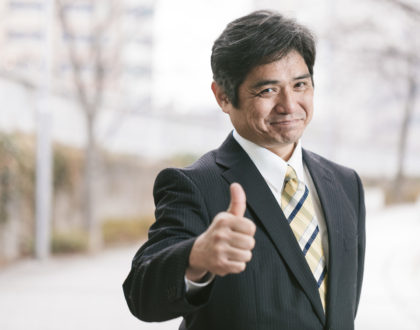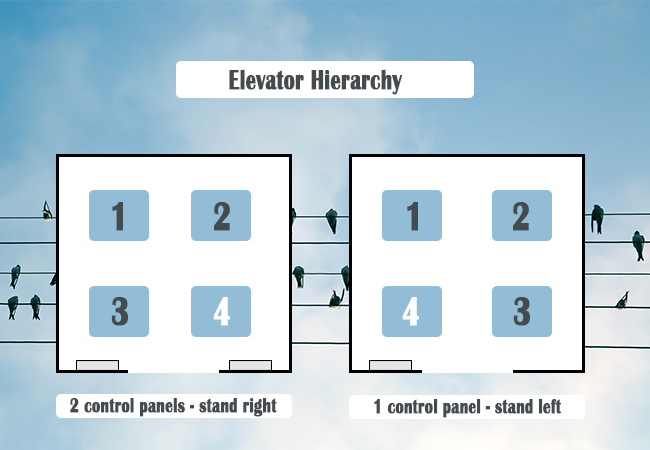Elevator Etiquette in Japan

by Madelaine
Riding an elevator can be tricky in Japan. Did you ever notice the person that is pushing the ‘open’ button the entire time? Or how the person closest to the panel always seems to be leaving last?
In most places around the world, there are no special rules on how to ride the elevator, people just act based on common sense without thinking too much about it. Japan, on the other hand, has a clear riding etiquette in place, that most Japanese follow as naturally as lining up in front of an escalator.
コンテンツ
Manning the ship the casual way
- If you enter the elevator first, congratulations! You just received authority over all the buttons!
- To fulfill your task, stand in front of the control panel, and push the door open button for everyone else who is getting on. As special service, help communication between passengers and vehicle, by asking on which floor everyone is getting off.
- Quickly push (and hold) the close door button as soon as everyone is on board until the doors are safely shut. You wouldn’t want to make anyone wait.
- Pushing the buttons and holding the door let’s you practice your reaction speed at every floor you arrive at. A crowd pushing out, a single person rushing in just as the doors are about to close – your doorman-ship can handle them all.
- On your floor, again hold the door so everyone can get out. You see everyone out safely before you leave. The closest person now will take over your spot and hold the door for you and incoming passengers.
These rules are common sense in Japan and you will see people acting accordingly, regardless of whether they are in the office or at the mall.
- 6. If someone is already inside and you don’t get to push the buttons, but are standing close to the doors, leave the elevator each time it stops, so people behind you can get out. Then enter again, this time someone will hold the door for you.
Elevator rules business style
So, Japanese people like to play lift conductor and are considerate. Did we really need an article for this?
(Un)Fortunately in business settings, there are a couple of rules about when to enter, or where to stand. They are all based on one simple concept: hierarchy.
1. Getting on the elevator
- 7. The youngest, most junior person jumps into an empty elevator first, to hold the door open for the senpai. It’s a rare opportunity to go through a door before your superiors. Traditionally the higher ups always go first.
- 8. While going in say お先に失礼いたします, so everyone know which scenario to act out. (Otherwise, you entering before superiors or clients, could be seen as rude behavior.)
- 9. Greet people as they get on and push the buttons for them. Ideally you know where (almost) everyone from your company is working, otherwise ask for their floor with 何回でしょうか.
- 10. If there are already people on the elevator, take a step back and enter after clients, and higher ups.
2.On the elevator
You can see someone’s status in a company by where they stand in the elevator. Same as in conference rooms, the lower-ranking employees will be close to the door, and the higher ups toward the back.
- 11. If you enter an elevator where a higher up is already standing close to the door, you should say かわります and squeeze yourself in front of the control panel.
- 12. When you enter an elevator with two control panels, the 下座 (lowest position) is the one one the right, so go there.
That makes the spot that’s furthest away, on the far left, the 上座. If a customer is in the elevator, this place goes to them. Otherwise the highest-ranking person will take the spot. - 13. Proceed through stages 3-5.
- 14. On the elevator talking, eating or drinking, and using your phone is NG (Japanese for “not good”). You never know who is waiting on the other side when the doors open.
The only exception is a customer or superior starts talking first.
3. Getting off the elevator
- 15. If a colleague is getting off the elevator, push the open button and put your other hand in front of the door sensor to hold it open for them. Send them on their way with an おつかれさまです。
For a customer, say どうぞ。 こちらでございます and hold the door for them to step out. - 16. After anyone else from your floor got off, it is your turn to leave. When you leave, someone else will fill your spot. So far so good.
- 17. Say お疲れ様です。to everyone present.
- 18. Say thank you to whoever is holding the door open.
- 19. Bonus stage: push the close button as you exit. You wouldn’t want to make anyone wait.
I have seen this quite a few times, but I am not quite sure if it really makes the door close any earlier, or if your arm, or whole body blocking the sensor, makes the whole endeavor a pointless one.
These rules on how to ride an elevator in Japan sometimes conflict with more pragmatic approaches to riding elevators. That said, for most Japanese they seem to work just fine. At first you might fail and feel awkward, but with some practice you can nail it for sure!
Recommended Posts

How to Get Along with Your Japanese Boss
25 5月 2021 - Work, Working Culture

The 10 Most Popular Japanese Companies in 2021
19 5月 2021 - Work


